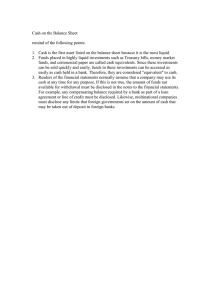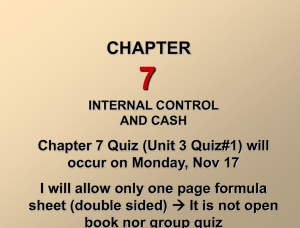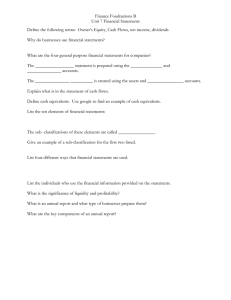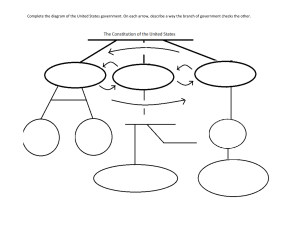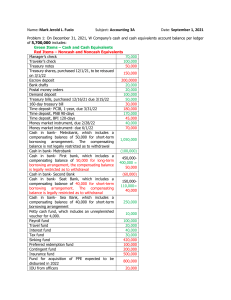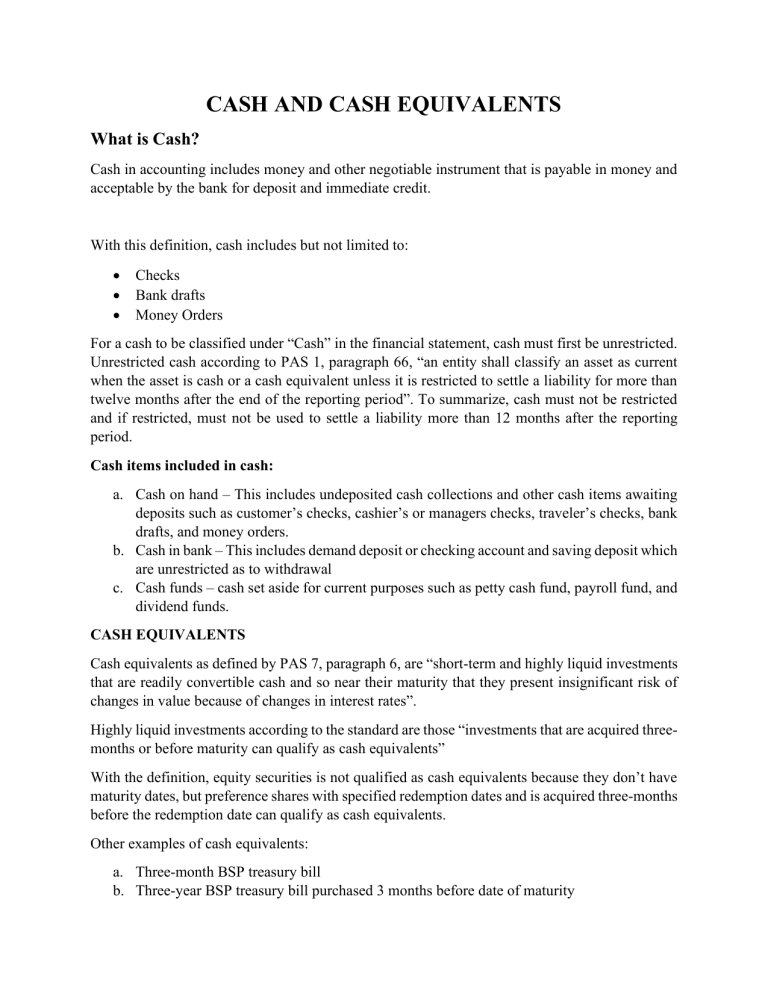
CASH AND CASH EQUIVALENTS What is Cash? Cash in accounting includes money and other negotiable instrument that is payable in money and acceptable by the bank for deposit and immediate credit. With this definition, cash includes but not limited to: • • • Checks Bank drafts Money Orders For a cash to be classified under “Cash” in the financial statement, cash must first be unrestricted. Unrestricted cash according to PAS 1, paragraph 66, “an entity shall classify an asset as current when the asset is cash or a cash equivalent unless it is restricted to settle a liability for more than twelve months after the end of the reporting period”. To summarize, cash must not be restricted and if restricted, must not be used to settle a liability more than 12 months after the reporting period. Cash items included in cash: a. Cash on hand – This includes undeposited cash collections and other cash items awaiting deposits such as customer’s checks, cashier’s or managers checks, traveler’s checks, bank drafts, and money orders. b. Cash in bank – This includes demand deposit or checking account and saving deposit which are unrestricted as to withdrawal c. Cash funds – cash set aside for current purposes such as petty cash fund, payroll fund, and dividend funds. CASH EQUIVALENTS Cash equivalents as defined by PAS 7, paragraph 6, are “short-term and highly liquid investments that are readily convertible cash and so near their maturity that they present insignificant risk of changes in value because of changes in interest rates”. Highly liquid investments according to the standard are those “investments that are acquired threemonths or before maturity can qualify as cash equivalents” With the definition, equity securities is not qualified as cash equivalents because they don’t have maturity dates, but preference shares with specified redemption dates and is acquired three-months before the redemption date can qualify as cash equivalents. Other examples of cash equivalents: a. Three-month BSP treasury bill b. Three-year BSP treasury bill purchased 3 months before date of maturity c. Three-month time deposit d. Three-month money market instrument or commercial paper ITEMS AND ISSUES UNDER CASH INVESTMENT IN EXCESS OF CASH The control and proper use of cash is an important aspect of cash management. Basically, the entity must maintain sufficient cash for use in current operations. Any cash accumulated in excess of that needed for current operations should be invested even temporarily in some type of revenue earning investment. Accordingly, excess cash may be invested in time deposits, money market instruments, and treasury bills for the purpose of earning interest income. Classification of Investment in Excess of Cash Investments in time deposit, money market instruments, and treasury bill should be classified as follows: a. Cash or Cash Equivalents – if the term is 3 months or less b. Short term investments – if the term is more than 3 months but less than one year c. Long term investments – if the term is more than one year, but if it is due within one year, then it is reclassified as short term investments MEASUREMENT OF CASH • • • Cash is generally measured at face value Cash in foreign currency is record at current exchange rate a) Cash in foreign currency should be translated to Philippine peso using the current exchange rate b) Deposits in foreign countries that are not subject to any foreign exchange restriction should be included in cash c) Deposits in foreign bank which are subject to foreign exchange restriction , if material, should be classified separately among non-current assets and clearly indicate the restriction. Cash held by a bank or financial institution experiencing bankruptcy should be recorded at estimated realizable value, if the amount recoverable is estimated to be lower than the face value. FINANCIAL STATEMENT PRESENTATION The line item for cash items is called “cash and cash equivalents” and must be presented as the first line item under current assets. This line item includes all that qualifies as cash and cash equivalents but the details comprising the said line item should be disclosed in the notes of financial statements. CASH FUND FOR CERTAIN PURPOSE • If the cash fund is set aside for current operations or for the payment of current obligation, it is qualified for current asset and under cash and cash equivalents. Examples are: a) Petty Cash fund b) Payroll Fund c) Travel Fund d) Interest Fund e) Dividend Fund f) Tax Fund • But if the cash fund is set aside for non-current operations or non-current obligation, it is shown as long-term investments, examples are: a) Sinking Fund b) Redemption Fund c) Contingent Fund d) Insurance Fund e) Fund for acquisition or construction of PPE BANK OVERDRAFT When a cash in bank account has a credit balance, it is said to be an overdraft. The credit balance in the cash in bank account results from the issuance of checks in excess of the deposits. In this case, bank overdraft is classified as a current liability and should not be offset against other bank accounts with debit balance. But it is not necessary to open a new ledger for bank overdraft account, rather it is presented as credit in the Cash in Bank – Related Bank. Generally, bank overdraft is not permitted in the Philippines. Exception to rule on overdraft • • • When an entity maintains two or more accounts in one bank and one account results in overdraft, such overdraft can be offset against other bank accounts with a debit balance, in this case it is shown as “net of bank over draft, bank overdraft, or net of other bank accounts”. An overdraft can also be offset against the other bank account if the amount is not material. IFRS provides that bank overdraft can be offset against other bank account when payable on demand and often fluctuates from positive to negative as an integral part of cash management. COMPENSATING BALANCE A compensating balance generally takes the form of minimum checking or demand deposit account balance that must be maintained in connection with a borrowing arrangement with a bank. For example, an entity borrows P5,000,000 from a bank and agrees to maintain a 10% or P500,000 minimum compensating balance in the demand deposit account. In effect, this arrangement results in thje reduction of the amount borrowed because the compensating balance provides a source of the fund to the bank as partial compensation for the loans extended. Classification of compensating balance • • • If the deposit is not legally restricted as to the withdrawal by the borrower because of an informal compensating balance agreement, the compensating balance is part of cash If the deposit is legally restricted because of a formal compensating balance agreement, the compensating balance is classified separately as “cash held as compensating balance” under current assets if the related loan is short-term. If the related loan is long-term, the compensating balance is classified as noncurrent investment. CHECKS Undelivered Checks An undelivered or unreleased check is none that is merely drawn and recorded but not given to the payee before the end of the reporting period. Thereby we can assume that there is no payment done because the said check is pending on delivery to the payee at the end of the reporting period. The reason for such assumption is because the check is within the entity control and can be cancelled any time before the delivery. Thereby needing to adjust the entry to correct the cash balance. Hence, the entry as Cash Pxxxxxx Accounts Payable or any appropriate account Pxxxxxxx In practice, the adjustment is sometimes ignored because the amount is not very substantial and there is no evidence of actual cancelation of the check in subsequent periods. Postdated check delivered A postdated check delivered is a check drawn, recorded, and already given to the payee but it bears a date subsequent to the end of the reporting period. Like undelivered checks, it is assumed as if the there is no payment done because the payee can only present the check after or during the written date. Thereby needing to adjust the entry to correct the cash balance. Hence, the entry as Cash Pxxxxxx Accounts Payable or any appropriate account Pxxxxxxx Stale Checks A stale check is a check not encashed by the payee within a relatively long period of time. Long period of time as defined by most banking practice is after 6 months from the time of issuance. Thereby a check not encashed within 6 months is labeled as stale check. Adjustments for stale checks is dependent on the scenario and they are as follows: • If the amount of stale check is immaterial, it is simply, accounted for as miscellaneous income. Cash Pxxxxxx Miscellaneous Income Pxxxxxxx • If the amount is material and the liability is expected to continue, the cash is restored and the liability is again set-up. Cash Pxxxxxx Accounts Payable or any appropriate account Pxxxxxxx
